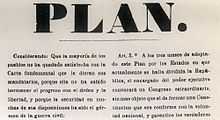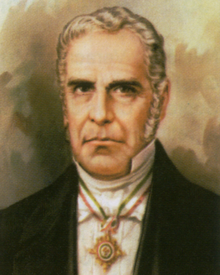Plan of Tacubaya

Plan of Tacubaya, also known as Tacubaya Plan or War of the Three Years (Spanish: Plan de Tacubaya) was formulated to abolish the Reform Laws by Benito Juárez. In Mexico the new constitution was rejected by a large part of society, which had the support of the clergy and the army. Comonfort, aware of the limitations imposed by the new regime, proposed reforms to strengthen the government and mitigate "radical" measures; however, Congress rejected them. Given the delicate situation, Félix Zuloaga and other generals convinced Comonfort to convene another congress to draft a new constitution more in keeping with the customs of the nation. On December 17, 1857, Zuloaga proclaimed the Plan of Tacubaya. Comonfort joined the Plan of Tacubaya, which began the three-year war.[1]
Reform Laws

The laws enacted by Benito Juárez in Veracruz, while besieging the port, known as Reform Laws, finally established the separation of Church and State. The July 12, 1859 was enacted nationalization of church property, the 23, the Civil Marriage Act, the Organic Law 28 Civil Registry and the Law on the civil status of persons, and 31, the decree stating that any intervention by the clergy ceased in cemeteries and graveyards. August 11 The holidays were regulated and prohibited government assistance to the functions of the Church. A year later, on December 4, 1860, was issued the Law on religious freedom. These laws were the beginning of a new era in politics, economics and culture. But while these arrangements became reality, the civil war had exhausted and impoverished the country.
Government of Benito Juarez
- Nationalization Law Ecclesiastical Property: This law complements the Lerdo Law of confiscation of the goods of the Church, with an important change: the goods and not passed into the hands of shareholders. It was issued in Veracruz on July 12, 1859.
- Civil Marriage Act: was issued in Veracruz on July 23, 1859; by this law established that religious marriage had no official validity and established marriage as a civil contract with the State, eliminating the forced intervention of priests and the collection of the same by the churches.
- Civil Registration Act: civil status registration of people left in charge of government employees and not of the Church. They declared births and deaths as a civil contract with the state. It was issued in Veracruz on July 28, 1859. Decree of secularization of cemeteries declared the cessation of all involvement of the clergy in graveyards and cemeteries; was released in Veracruz on July 31, 1859.
- Decree suppression of religious holidays: by this decree declared the days that were to be taken as holidays, prohibiting government assistance to religious functions. It was released in Veracruz on August 11, 1859.
- Law on religious freedom: under this law Catholicism ceased to be the only faith allowed. This law allowed that each person was free to practice and choose the cult he wanted to follow, if any, also prohibited the performance of ceremonies outside the churches or temples. It was issued in Veracruz on December 4, 1860.
- Decree of Expulsion: by which ordered the exile of Louis Clementi, apostolic delegate, Archbishop José Lázaro de la Garza y Ballesteros and Bishops Pedro Espinosa and Pedro Davalos and Barajas and Moreno. It was released in Mexico City on January 21, 1861.
- Decree of hospitals and charitable institutions: by which these properties were secularized. It was released in Mexico City on February 2, 1861.
- Decree of secularization of nuns and friars: dissolving all cloisters and convents, dipossessing the religious who lived there, with the exception of the Sisters of Charity.
Presidents of Mexico
Presidents recognized by the Conservatives during the Reform War
| President | Took office | Left office | Notes | |
|---|---|---|---|---|
 |
Ignacio Comonfort (1812–1863) |
December 17, 1857 | January 21, 1858 | After the declaration of Plan of Tacubaya, Congress declared that he was no longer president but he was recognized by conservatives as president with absolute powers.[2][3] |
.png) |
Félix María Zuloaga (1813–1898) |
January 11, 1858 | December 24, 1858 | After disowning Comonfort, Zuloaga was appointed president by the Conservative Party.[4] |
.png) |
Manuel Robles Pezuela (1817–1862) |
December 24, 1858 | January 23, 1859 | He assumed the conservative presidency with the support of the Plan de Navidad.[5][6] |
.png) |
Félix María Zuloaga (1813–1898) |
January 24, 1859 | February 1, 1859 | He was restored to the presidency by a counter-rebellion led by Miguel Miramón.[5][7] |
.png) |
Miguel Miramón (1831–1867) |
February 2, 1859 | August 13, 1860 | He assumed the conservative presidency as a substitute when Zuloaga left office.[8] |
 |
José Ignacio Pavón (1791–1866) |
August 13, 1860 | August 15, 1860 | As president of the Supreme Court of the conservative government, he took office for two days when Miramón left office.[9] |
.png) |
Miguel Miramón (1831–1867) |
August 15, 1860 | December 24, 1860 | He took office as interim president of the conservative government after he was elected by a group of "Representatives of the States" who supported the conservatives. He was defeated at the Battle of Calpulalpan, resigned the presidency and fled the country.[10] |
.png) |
Félix María Zuloaga (1813–1898) |
May 23, 1860 | December 28, 1862 | Despite having been defeated, the conservatives appointed Zuloaga as president until December 28, when they recognized the Regency who was seeking to reestablish the Mexican Empire.[11] |
References
- ↑ Plan of Tacubaya, December 17, 1857, Historical Documents Digital Library Bicentennial, Federal Government
- ↑ "Es proclamado el Plan de Tacubaya, con el que los conservadores pretenden derogar la Constitución de 1857.". Memoria Politica de México. Retrieved April 29, 2013.
- ↑ "El Congreso declara que dejó de ser Presidente de la República don Ignacio Comonfort desde el 17 de diciembre de 1857.". 500 años de México en documentos. Retrieved April 29, 2013.
- ↑ "Tras desconocer a Comonfort, Félix María Zuloaga es nombrado presidente por el partido conservador.". Memoria Politica de México. Retrieved April 30, 2013.
- ↑ 5.0 5.1 "Asume la presidencia del gobierno conservador el general Manuel Robles Pezuela.". Memoria Politica de México. Retrieved April 30, 2013.
- ↑ "Plan de Navidad.". Memoria Politica de México. Retrieved April 30, 2013.
- ↑ "FÉLIX MARÍA ZULOAGA (1813-1898).". Bicentenario de México. Retrieved April 30, 2013.
- ↑ "Zuloaga nombra presidente sustituto de la República a Miguel Miramón.". Memoria Politica de México. Retrieved April 30, 2013.
- ↑ "José Ignacio Pavón, presidente de la Suprema Corte, se encarga durante dos días del poder ejecutivo del gobierno conservador.". Memoria Politica de México. Retrieved April 30, 2013.
- ↑ "Toma posesión como presidente interino de la República, Miguel Miramón. Juárez sigue siendo el presidente legal.". Memoria Politica de México. Retrieved April 30, 2013.
- ↑ "Felix Maria Zuloaga.". Chihuahua, México. Retrieved April 30, 2013.